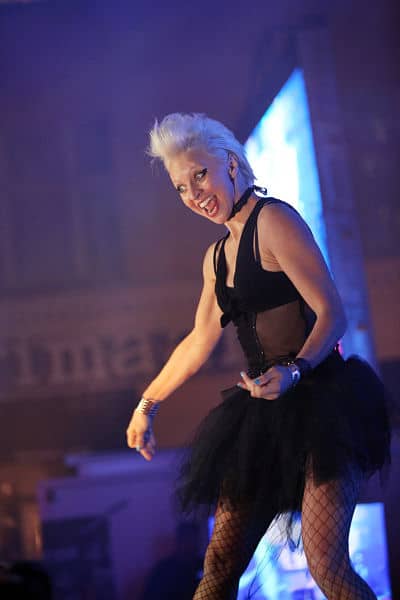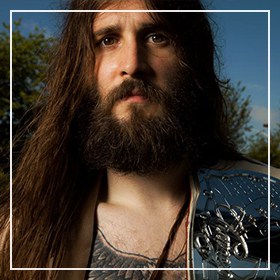On arriving at Oulu, Finland’s airport, signs somewhat cheekily announce “You’re in a smart city.” The proud reference to Oulu’s ranking as one of the world’s seven most intelligent communities is a departure from Finns’ generally reserved, modest, and reticent personalities, and it might seem even more surprising that each August Oulu is home to the Air Guitar World Championship’s crowd of loud and colorful extroverts. For 19 years a host of international visitors have descended on Oulu parading about town playing invisible musical instruments and championing the egalitarian art of air guitar. The two of us have been among that crowd for several years, with one of us winning the title of Air Guitar World Champion in 2012 and the other in the crowd as a participant-observer.
It is easy to dismiss air guitar as a meaningless leisure, but we want to suggest that air guitar might be more productively understood to be a folk expressive art; that is, air guitar unites music, dance, and theater in an expressive art that admits everyone, can be reproduced infinitely, and expresses common ideals if not values.
The fundamentals of air guitar performance remain consistent over time even as each performer brings their own subtle variations to performance, so it is a distinctive public theater accessible to nearly anybody who is part of global popular culture and knows the core traditions set out by the likes of Chuck Berry, Bo Diddley, and Stevie Ray Vaughn. Across an astounding array of cultural divides, we share recognition of Elvis’ swagger, Angus Young’s duckwalk, and Jimi Hendrix’s stage presence, bound together by music and great performers in ways that air guitar embraces and aspires to expand.
 Perhaps the most fascinating dimensions of air guitar are its utterly democratic ambitions and egalitarian (or at least idealistic) politics. The Air Guitar World Championship optimistically argues that its aspiration is to “promote world peace. According to the ideology of the Air Guitar, wars would end, climate change stop and all bad things disappear, if all the people in the world played the Air Guitar.” There is not especially good scientific evidence that climate change will be arrested by interpretations of Duane Allman, but that brash idealism is made possible by the accessibility of air guitar. Air guitar’s unique performance of camp, confidence, naïve sincerity, self-aware insignificance, and playful theatre is quite possibly among the most accessible of all expressive arts.
Perhaps the most fascinating dimensions of air guitar are its utterly democratic ambitions and egalitarian (or at least idealistic) politics. The Air Guitar World Championship optimistically argues that its aspiration is to “promote world peace. According to the ideology of the Air Guitar, wars would end, climate change stop and all bad things disappear, if all the people in the world played the Air Guitar.” There is not especially good scientific evidence that climate change will be arrested by interpretations of Duane Allman, but that brash idealism is made possible by the accessibility of air guitar. Air guitar’s unique performance of camp, confidence, naïve sincerity, self-aware insignificance, and playful theatre is quite possibly among the most accessible of all expressive arts.
Air guitar has a fundamentally egalitarian ethic, accessibility, and non-judgmental standards so it constructs community in similarly broad and inclusive ways that admit entrance to everybody.
Expressive arts like guitar playing, dancing, singing, or acting are of course displays of technical skill, creativity, and performance talent that separate great artists from those of us in the audience. In contrast, anybody can play air guitar; the air guitarists who strode the stage in Oulu in August are perhaps distinguished by their imagination, confidence, and theatricality, but much of the allure of air guitar rests with its absolutely egalitarian appeal and an acceptance of all performances. The very act of playing an invisible guitar in front of strangers would inspire anxiety in many of us, but air guitarists accept the sincere efforts of performance and the love of music, which creates a very powerful sense of community among air guitarists.
 Air guitar performances hope to evoke the emotional impact of Eddie Van Halen, rather than the technical skills that produce a particular sonic experience; consequently, playing air guitar involves a quite distinctive set of performance skills. Air guitarists aspire to capture the emotional thrill of guitar masters’ performances and display the nuances of musicians’ bodily playing, ranging from prosaic hand motions to physical stance to facial expressions. In many ways, they face a distinct challenge because the performance itself must make an audience feel moved by the emotional power of an air guitarist who is interpreting music yet not creating it. Air guitarists may not actually “play” music, but they acknowledge, embrace, and then display our emotional and bodily responses to music and build a distinctive community that revolves around the pleasures of performance and acceptance.
Air guitar performances hope to evoke the emotional impact of Eddie Van Halen, rather than the technical skills that produce a particular sonic experience; consequently, playing air guitar involves a quite distinctive set of performance skills. Air guitarists aspire to capture the emotional thrill of guitar masters’ performances and display the nuances of musicians’ bodily playing, ranging from prosaic hand motions to physical stance to facial expressions. In many ways, they face a distinct challenge because the performance itself must make an audience feel moved by the emotional power of an air guitarist who is interpreting music yet not creating it. Air guitarists may not actually “play” music, but they acknowledge, embrace, and then display our emotional and bodily responses to music and build a distinctive community that revolves around the pleasures of performance and acceptance.
Air guitar’s energetic public performance and unassuming goofiness may contrast with Finnish cultural restraint. However, Finns certainly are not alone embracing disciplinary codes of restraint, rationality, and self-consciousness that discourage many of us from unleashing our best Johnny Ramone interpretation.
Air guitarists celebrate the innocent pleasures of unfettered and sincere expression that many of us entertained as children but have now suppressed beneath behavioral disciplines. Air guitar’s pretensions for world peace and ambitious goals counter-intuitively come from the least self-important of all arts, a people’s folk expression in which the most prominent performers and their desires are indistinguishable from our own. Certainly some zealous critics see air guitar as an assault on the high art of metal, but like nearly any art, air guitar is not really an interesting subject of analysis if it is simply reduced to musical virtuosity and technical performance. Instead, it provides a rich insight into contemporary life if we see it as a performance that imagines and expresses pleasure and community and unites people with common ideals.
 (Image: Justin “Nordic Thunder” Howard by Alyce Henson)
(Image: Justin “Nordic Thunder” Howard by Alyce Henson)






